Subtracts two variables. It returns the difference of x and y. It is performed element-wise if the arguments are vectors, matrices or signals. Inputs must be of the same size and the same type unless the second variable is a scalar.
Syntax
x-y
Types
| Variable Name | Value Type | Variable Type | ||
|---|---|---|---|---|
| Arguments: | x | real, complex | scalar, vector, matrix, signal, xy-data | |
| y | real, complex | scalar, vector, matrix, signal, xy-data | ||
| Result: | z | real, complex | scalar, vector, matrix, signal, xy-data | |
Calculator Input
Use the button to complete the operation.
Examples
Subtract Scalar from Scalar
| ID | Description | Type | Value | Expression | |
|---|---|---|---|---|---|
| x | Argument | REAL | 2 | 2 | |
| y | Argument | REAL | 3 | 3 | |
| z | Result | REAL | -1 | x-y | |
Subtract Scalar from Vector
| ID | Description | Type | Value | Expression | |
|---|---|---|---|---|---|
| x | Argument | REAL VECTOR |
| [2, 2.5] | |
| y | Argument | REAL | 3 | 3 | |
| z | Result | REAL VECTOR |
| x-y | |
Subtract Vector from Vector (Same Size)
| ID | Description | Type | Value | Expression | |
|---|---|---|---|---|---|
| x | Argument | REAL VECTOR |
| [2, 2.5] | |
| y | Argument | REAL VECTOR |
| [3, 3.5] | |
| z | Result | REAL VECTOR |
| x-y | |
Subtract Scalar from Matrix
| ID | Description | Type | Value | Expression | |
|---|---|---|---|---|---|
| x | Argument | REAL MATRIX |
| [[2, 2.5, 3],[3.5, 4, 4.5]] | |
| y | Argument | REAL | 1 | 1 | |
| z | Result | REAL MATRIX |
| x-y | |
Subtract Matrix from Matrix (Same Size)
| ID | Description | Type | Value | Expression | |
|---|---|---|---|---|---|
| x | Argument | REAL MATRIX |
| [[2, 2.5],[1, 1]] | |
| y | Argument | REAL MATRIX |
| [[1, 1],[3, 3.5]] | |
| z | Result | REAL MATRIX |
| x-y | |
Subtract Scalar from Signal
| ID | Description | Type | Value | Expression | |
|---|---|---|---|---|---|
| x | Argument | REAL SIGNAL | 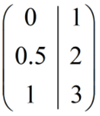 | signal([0, 0.5, 1],[1, 2, 3]) | |
| y | Argument | REAL | 1 | 1 | |
| z | Result | REAL SIGNAL | 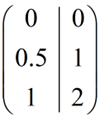 | x-y | |
Subtract Signal from Signal (Same Size)
| ID | Description | Type | Value | Expression | |
|---|---|---|---|---|---|
| x | Argument | REAL SIGNAL |  | signal([0, 0.5, 1],[1, 2, 3]) | |
| y | Argument | REAL SIGNAL | 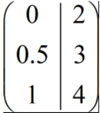 | signal([0, 0.5, 1],[2, 3, 4]) | |
| z | Result | REAL SIGNAL | 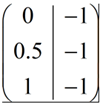 | x-y | |
Subtract Signal from Signal (Different Size)
| ID | Description | Type | Value | Expression | |
|---|---|---|---|---|---|
| x | Argument | REAL SIGNAL |  | signal([0, 0.5, 1],[1, 2, 3]) | |
| y | Argument | REAL SIGNAL | 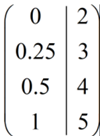 | signal([0, 0.25, 0.5, 1],[2, 3, 4, 5]) | |
| z | Result | REAL SIGNAL |  | x-y | |
If the axes of abscissae are different, the signal is interpolated to the additional abscissa values by linear interpolation.


